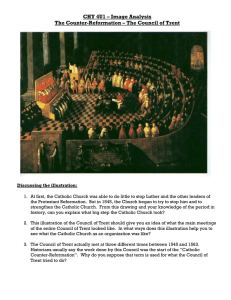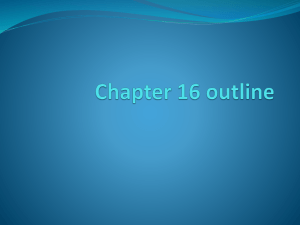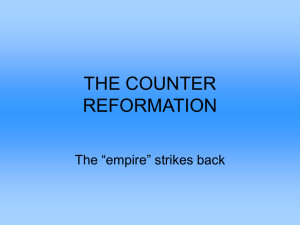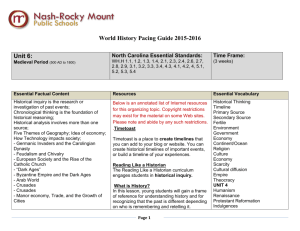HOCC Section 3, Part 2
advertisement
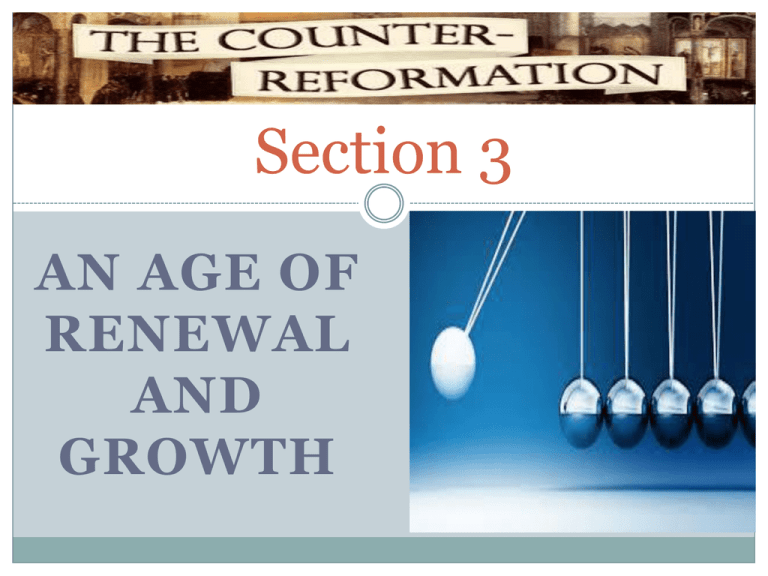
Section 3 AN AGE OF RENEWAL AND GROWTH Section 3, Part 2 CATHOLIC RENEWAL IN THE SIXTEENTH AND SEVENTEENTH CENTURIES Introduction Luther’s Ninety-five theses in 1517 Church thought it would blow over When it did not & after it had altered the religious-political landscape of Europe, the Church’s response was long overdue Council in Trent, Italy was planned in 1537 but delayed until 1545 Four sessions from 1545 to 1563 Most significant council since Lateran IV in 1215—reforms in doctrine & life Was the systematic, top-down institutional reform of the Counter Reformation Inspired a grass roots, bottom-up, spontaneous reform as well 2 Articles (A. 30) – The Council of Trent (A. 31) – Catholic Reformation & New Religious Orders Article 30: The Council of Trent Church members who stayed loyal to the Church were seeking reform Grass root efforts began even before the council since it was delayed Official response came in the form of an ecumenical council The Council of Trent (1545-1563) Pope Paul III (1534-1549) overcame political reluctance & called council Cardinals opposed but approved for May 1537; delayed until December 1545 Held in Trent, Italy (southern alps) Only half of world’s 500 bishops attended any session Session 1 & 2—1545-1549 (Paul III); panic over wars & epidemics Session 3—1551-1552 (Julius III); disagreement Session 4—1562-1563 (Pius IV); business concluded Initiated the Catholic Reformation or Counter Reformation as it is known Clarified & defined doctrine & practice of the Church Pure & reactionary motives shaped the Church for centuries to come Article 30 cont.: The Council of Trent Most Important Cannons & Decrees—why for each Creed—Nicene Creed was affirmed as the confession of faith Scripture—Deuterocanonical books are part of Scripture & are not apocrypha; Vulgate is authoritative version of bible Original Sin—Original Sin is valid & Baptism takes away Justification—justified by grace; accept grace in faith; cooperate by works; saved by grace not merit; merit grace by works but works is by grace Sacraments—7 Sacraments are valid Eucharist—Transubstantiation & Real Presence are valid Ave Verum Corpus—Eucharistic hymn of Thomas Aquinas Mass—sacrifice, memorial, & makes his sacrifice present liturgically Priesthood—indelible mark of Holy Orders; celibacy upheld Founding of Seminaries—every diocese must have one to train priests Marriage—must be witnesses by a priest & two other witnesses Pius IV (1559-1565) published decrees & began to implement Pius V (1566-1572)—Roman Catechism, Breviary, & Missal You Tube Videos: Section 3, Part 2 Fr. Barron: The Council of Trent The Council of Trent Homework Section 3, Part 2 review questions 1-2, 4, & 6 Article 31: The Catholic Reformation & New Religious Orders Council had little immediate effect in already Protestant countries/cities Fruit of the council was in Catholic countries/cities A primary fruit was the reform of existing orders & the formation of new orders according to the canons & decrees of the council Society of Jesus (Jesuits—SJ) Saint Ignatius of Loyola (1491-1556) Soldier injured in battle; converted through reading while recovering Spiritual Exercises 3 criteria for discernment: good, free, effort Studied for priesthood in Paris; formed original seven members Education and four vows; approved by Paul III in 1540 Discalced Carmelites (OCD) St. Teresa of Avila (1515-1582) & St. John of the Cross (1542-1591) Joined Carmelites; left to start reform of Carmelites—poverty, prayer, simplicity rather than materialism & superficiality—after failed reform St. John of the Cross brought reform to men as Theresa spread reform for women around Spain—spiritual correspondence “Interior Castle” & “Dark Night of the Soul” on contemplative prayer Article 31 cont.: The Catholic Reformation & New Religious Orders Other spontaneous reform through holiness St. Peter Canisius (1521-1597) German Jesuit who attended Council & implemented after through counseling bishops & princes, writing catechisms, & founding universities St. Charles Borromeo (1538-1584) Archbishop of Milan; nephew of Pius IV; seminaries for priestly training St. Robert Bellarmine (1542-1621) Italian Jesuit cardinal; wrote about & implemented reforms of Trent; esp. residency of bishops; sought to systematize theological issues of the time St. Francis de Sales (1567-1622)—writers, editors, and journalists Bishop of Geneva; accomplished preacher; converted many Protestants back to Church; “Introduction to the Devout Life” on prayer, Sacraments, & devotion in all walks of life = evangelization St. Jane Frances de Chantal (1572-1641) Pupil of Francis de Sales; from France; began Order of the Visitation of Holy Mary for women after he husband died Cultural changes: Baroque to Rococo; elaborate Latin texts under Palestrina (1526-1594) You Tube Videos: Section 3, Part 2 The Catholic Counter- Reformation (AP Euro) The Counter Reformation Homework Section 3, Part 2 review questions 3 and 5 Study for the Section 3, Part 2 quiz Wednesday Make sure the Section 3, Part 2 review questions 1-6 are ready to turn in Tuesday
